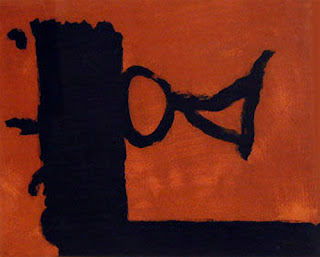Why I Am Not a Painter
I am not a painter, I am a poet.
Why? I think I would rather be
a painter, but I am not. Well,
for instance, Mike Goldberg
is starting a painting. I drop in.
"Sit down and have a drink" he
says. I drink; we drink. I look
up. "You have SARDINES in it."
"Yes, it needed something there."
"Oh." I go and the days go by
and I drop in again. The painting
is going on, and I go, and the days
go by. I drop in. The painting is
finished. "Where's SARDINES?"
All that's left is just
letters, "It was too much," Mike says.
But me? One day I am thinking of
a color: orange. I write a line
about orange. Pretty soon it is a
whole page of words, not lines.
Then another page. There should be
so much more, not of orange, of
words, of how terrible orange is
and life. Days go by. It is even in
prose, I am a real poet. My poem
is finished and I haven't mentioned
orange yet. It's twelve poems, I call
it ORANGES. And one day in a gallery
I see Mike's painting, called SARDINES.
(1971)
Famous Artists Quotations
The invention of beauty by the Greeks, that is, their postulate of beauty as an ideal, has been the bugbear of European art and European aesthetic philosophies. Man’s natural desire in the arts to express his relation to the absolute became (so, fh) identified and confused with the absolutism of perfect creations… … so that the European artist has been continually involved in the moral struggle between notions of beauty and the desire for sublimity.
“There are moments in our lives, there are moments in a day, when we seem to see beyond the usual- become clairvoyant. We reach then into reality. Such are the moments of our greatest happiness. Such are the moments of our greatest wisdom. It is in the nature of all people to have these experiences; but in our time and under the conditions of our lives, it is only a rare few who are able to continue in the experience and find expression for it.”
Complete Interview with Clement Greenberg
From a 1991 Interview with Clement Greenberg:
The trouble with Michelangelo's sculpture is that it's too slick. He was damned good, but he was too arty. He introduced artiness, and I could have said -- that wouldn't have been talking precisely about Michelangelo -- that European sculpture began to slope downhill after Donatello (who was a better sculptor than Michelangelo). After Michelangelo there was Giambologna, who was ok, and the famous sculptors who came after: Canova, Thorvaldsen in the early l9th century...
Rodin began it all over again -- somewhat. Rodin, Maillol, Despiau. Kolbe in Germany. And then of course there was the great rebirth of sculpture with Picasso's 1913 construction "The Guitar" in the Museum of Modern Art that started sculpture on a new trajectory. OK, let's look at famous Michelangelo. The best Michelangelo I've seen are the unfinished 'slaves' in the Borgo. They're the best. In order to be good as a sculptor, Michelangelo had to leave things unfinished. And they're still not as good as Donatello.
Vorticism
A radical English art movement, led by Wyndham Lewis and named by the poet Ezra Pound in 1914. Lewis, EdwarWadsworth Gaudier-Brzeska and others exhibited together in Brighton in 1913, presenting their work as and in 'The Cubist Room'. In 1914 they published their first polemical year-book, BLAST and in 1915 they showed in London the Vorticist Exhibition which included several large paintings that are now lost. Essentially urban in its taste for hard, clear forms, Vorticism expressed great impatience with all Victorianism and all revivalism and sought to out-do the Post-Impressionist and Fauve modernism propagated by Roger Fry and his friends. Lewis met his associates when working in Fry's Omega Workshops; leaving with them after a disagreement with Fry, he adopted the vehemence and rhetoric of the Futurists in his onslaughts on Fry and made the Futurists' attempt to embrace industrial dynamism as the central concern of their art the concern also of Vorticism. Nevinson joined the group in 1913 but was the only one to call himself a Futurist. and Bomberg exhibited with them but did not become Vorticists. Though the war seemed an apt echo for their initially openly aggressive style and rhetoric - the subjects they used were neither necessarily aggressive nor even modern, though they shunned the French tendency to nudes, still lifes, domestic interiors and landscapes, preferring actions, even if the sources were classical antiquity or the Bible, rendered in varying degrees of abstraction — only Nevinson used his Vorticist art to make powerful images of it. The war and its aftermath also broke the group up and found alternative pursuits for its members. There is no exact end date for the movement. The June 1915 Vorticist Exhibition was the only one they put on, and the second and last came out in July 1915. That, in effect, was the end of Vorticist group activity.


